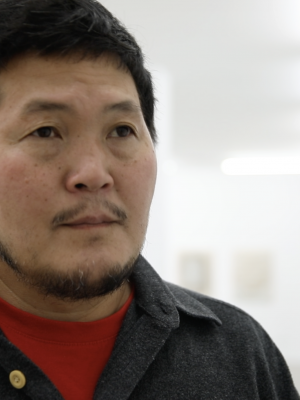
Dashdemed Sampil
Dashdemed Sampil, born in Mongolia in 1971, is a painter who lives and works in Nuremberg. After completing his Bachelor of Fine Arts at the University of Fine Arts in Ulan-Bator, he continued his studies at the Academy of Fine Arts in Nuremberg, where he became a master student of Prof. Peter Angermann.
Uncomfortable Pictures
Dashdemed Sampil is a calm observer in a chaotic world. His observations are the product of this simple yet powerful contrast. His strength lies in this contrast as well, and his calmness, considering his jarring observations, is merely astounding.
A disturbing mixture of crudeness and thin-shinnedness is the first thing that confronts the viewer of Dashdemed's paintings immediately and inevitably: being at the mercy of enigmatic and relentless circumstances, full of archaic memories, enticement, threat and barbaric sexual references. The coarse figures and their anatomical abnormalties and deformations disconcert us all the more because their attitudes are so normal and matter of fact.
Some might like to imagine the terrible and powerful evocation of chaos as otherwordly - and ultimately harmless. I fear, however, that it is entirely a part of human existence in the in the ever mysterious here and now. It is a look into an existing abyss, which opens not only next to those who can stand to look into it, like Dashdemed.
Man is a wolf to man; this shattering fact is stated passionately, yet without any bothersome sentimentality. There is no lachrymose accusation, no wagging finger and no cheap sarcasm. Finally there is no trace of cynical arrogance and absolutely no moralising undertone. This abstinence makes the statement all the more alarming.
Not everyone can bear such a vision. Many of Dashdemeds fellow students value the outstanding quality of his painting. Still the paintings make them feel uneasy. Dashdemed is, despite his friendly and lovable character, not a comforting painter. He is a sensitive berseker. The power of his paintings provokes understandable admiration as well as a series of strategies to protect and arrange oneself, to avoid or to rationalize the horror. Pychoanalysis is popular: as if that could rid the world of a disconcerting reality.
The best way to approach an artist of this caliber is not through analytical attacks or presumptuous interpretation attempts, but through an interest in technique.
You heard correctly: considering genuine vituosity, one should use one's own eyes again and search for those verifiable criteria that are rather avoided by contemporary art criticism. Please measure these paintings against the old traditional and proven, yet almost forgotten laws of composition, execution, use of color etc. What gives the paintings their incredible power? Aside from the basic prerequisite of inspiration, which Dashdemed posseses and we aknowledge gratefully - what makes these paintings so powerful from a traditional and formal point of view?
Firstly, Dashdemed Sampil chooses the right materials. Consistent with his approach, those are coarse canvases, pastose oilpaints and wide brushes. Then he composes his archaic figures in spaces full of tension. As already mentioned, Dashdemed forgoes anecdotal elements and superficial elegance.
The lack of any strictly realistic imagery brings out the suggestive potential. Magically intense brushstrokes evoke the figures. They are not simply shown, they act, conscious and determined, here and now, before our very eyes: often head-on, if not symmetrically, in a conclusive composition. The paintings are worked over and over until they makes sense formally. On the usually large canvases not a square inch of weariness is detectable. Everything is embeded in the general impression. Petty trickery is never needed.
In detail his gestures reveal amazing dynamics. We find vigorous, impulsive brushstrokes, languid brush marks and a highly deliberative, carefully scraped, graffiti-like hand writing, where the paint seems to have been scratched out of somewhere rather than applied. We are faced with a wide range of expressive means, which are handled competently and used in a concentrated way.
The stirring use of color, however, is the most complex aspect of Dashdemed's painting.
The incredibly rich colors draw their intensity more from an archaic and seemingly foreign intimacy, more from a cave-like interior than from broad daylight.
The glow builds up under warm, brownish layers, like within an earthen kiln. The glowing color glints through cracks, breaks forth in dramatic eruptions, cools and solidifies like magma on the surface and leaves the iridescent, livid and cold traces of it's alchemy. Dashdemed uses the same materials as all of us, of course. Yet regarding his paintings, one is prompted to doubt that such abundance of color, such affluence of surprising interplay of colors fits into the boundaries of conventional color systems.
Should one look for kindred spirits among painters or comparable artistic positions, one quickly finds Dashdemed to be a solitary phenomenon. He might fit into the company of the expressionists, which seem, however, too European all of a sudden. Without Western influences, on the other hand, Dashdemed's painting is unthinkable.
However unusual his perspective, the artists lets us paticipate intimately in his perceptive process. That is his true trump card. Our gaze and the painting itself arrange themselves calmly and concentratedly in the midst of a world full of smaller and larger crises. We feel and are involved as a figure fights its way into existence.
Genuine painting is nothing short of this: involving the viewer actively in the creative process, the composition and the unfolding of a vision. It lets us see as the artist saw.
Text by Peter Angermann from the catalogue: Dashdemed Sampil, 2011
Translation into English: Susanne and Dan Reeder
